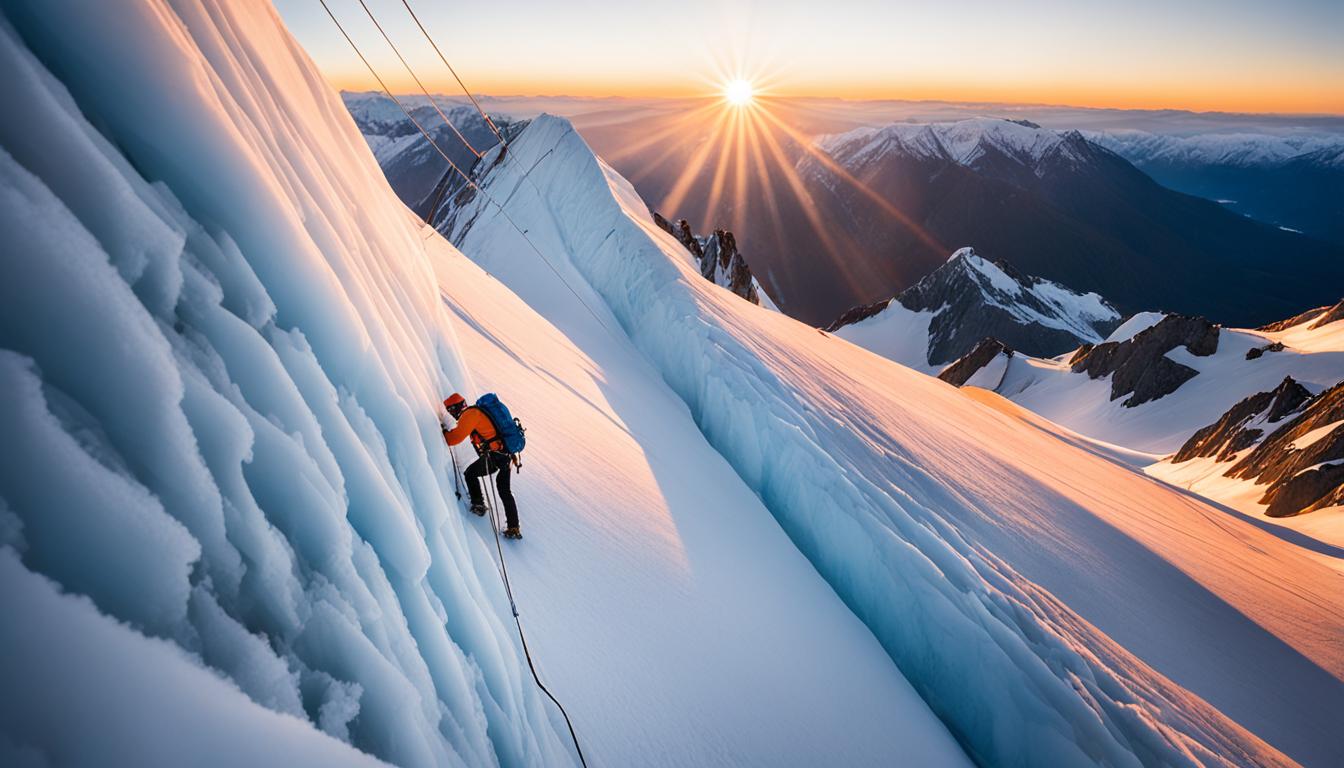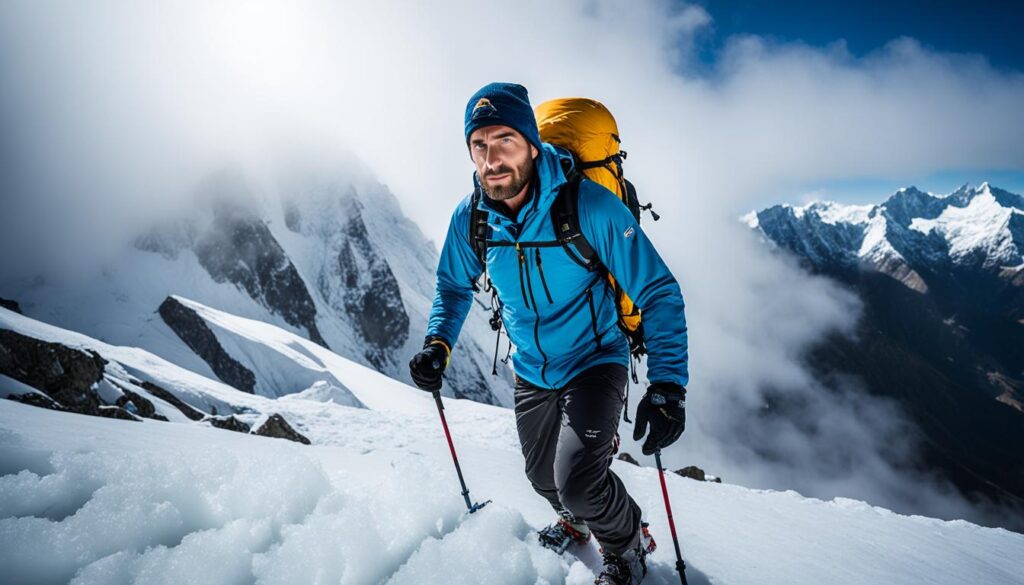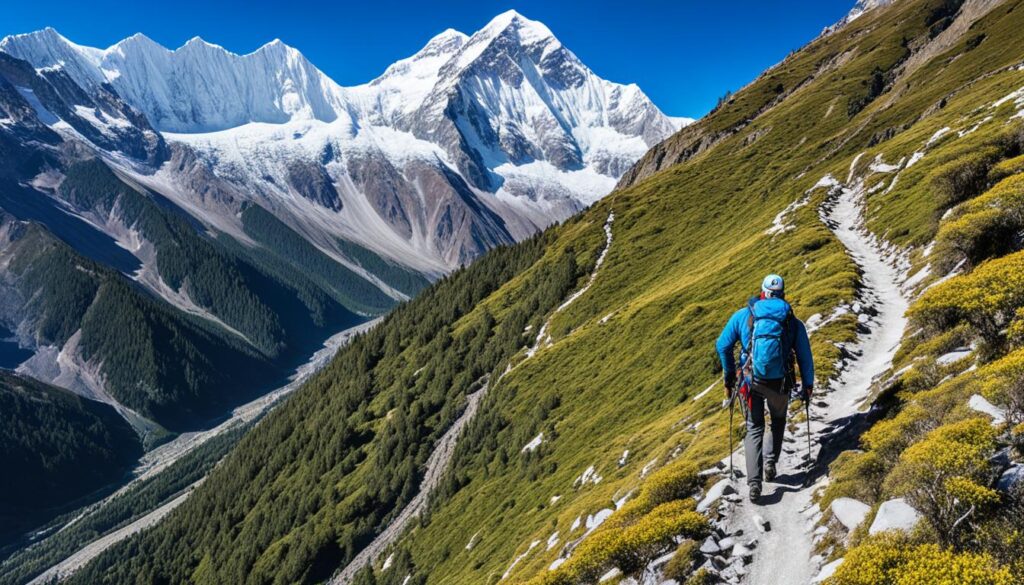
Mountaineering in Himalayas: Summit Your Dreams
There’s a magical feeling when you lace up your boots in the calm of early morning. You prepare your gear and look up at the massive Himalayas. This mix of excitement and awe has attracted adventurers for years. People come for the thrill of mountaineering in the Himalayas. They are drawn by the gorgeous landscapes and the monumental challenge of climbing.
The morning light shines on base camps, inspiring those setting off on mountaineering expeditions. With every step, climbers feel the call of adventure in the Himalayas. It’s not just about physical limits. It’s about reaching the highest peaks in the Himalayas and discovering one’s greatest potential. Though the climbers are diverse, their journeys share the same excitement as they reach for their dreams.
From experienced climbers to beginners, stories of trekking in the Himalayas fill the air. These tales weave into the rich history of Himalayan mountaineering. The risks are huge, but the rewards are even greater. This is where dreams challenge those who dare to achieve them.
The Allure of Himalayan Mountaineering
The hunt for Himalayan mountaineering thrills many. It draws them to the rough beauty of one of the world’s most honored mountain ranges. Reaching the top is as much about the body’s strength as it is about the soul’s toughness. This makes climbing in the Himalayas more than just an adventure.
Embarking on the Pursuit of Peak Ascension
Setting off through the Himalayan ranges to climb misty peaks is a challenge. It’s a step into adulthood. Climbers talk about the deep joy of overcoming each hill.
This joy changes their lives. It’s about people joining with nature’s raw beauty. This bond is only felt in the thin air, under the sky touched by the beauty of Himalayas.
Spiritual and Psychological Implications of Mountain Dreams
Climbers carry more than just a backpack. They bring mountain dreams. These dreams are about seeking enlightenment and finding inner calm. On these slopes, many find clear thoughts. The mountains stand as symbols for the hurdles we all face. The journey’s spiritual and psychological effects are as big as the physical effort.
The Intimidating Beauty of the Himalayan Ranges
The intimidating beauty of the Himalayan ranges draws climbers with a strong pull. Each view is like a live painting. It makes big dreams seem small and calms the spirit.
Whether under a peaceful dawn or hidden by fog, the Himalayas inspire deep respect. They are grand. Those who walk their trails do so loving the nature that’s like no other in climbing.
Essential Preparation for Climbing in Himalayas
If you’re drawn to climbing in the Himalayas, getting ready is key for a safe, successful trip. It’s important to have the right mountaineering gear for the varying landscapes and harsh weather you’ll face. Being in top physical fitness is also crucial. It helps you withstand the tough conditions of high-altitude climbing.
Learning how to deal with the thin air up high is vital. This means acclimatization strategies, like taking it slow and having rest days, are a must to avoid altitude sickness. Keeping an eye on the weather conditions is also essential. This can mean the difference between reaching the top or having to turn back. Knowing how to climb safely and having the right training is also a must.
Here’s a quick checklist for preparing for a Himalayan climb:
- Pick the right mountaineering gear for your climb.
- Work on a tough training regimen to build endurance, strength, and climbing skills.
- Go on high-altitude treks before your climb for good acclimatization.
- Talk to doctors about avoiding altitude sickness.
- Keep an eye on the weather conditions and have backup plans.
| Category | Preparatory Measures | Notes |
|---|---|---|
| Gear | Insulated boots, layered clothing, climbing harness | Quality and durability are key |
| Fitness | Cardio, strength training, flexibility exercises | Tailor to mountaineering demands |
| Acclimatization | Gradual elevation increase, hydrate plentifully | Monitor health throughout |
| Altitude Sickness | Familiarize with symptoms, carry necessary medication | Prevention is better than cure |
| Weather Conditions | Up-to-date forecasts, contingency plans | Be prepared to adjust itineraries |
| Training | Climbing techniques, safety protocols, rescue drills | Guidance from experienced mountaineers |
Following these essential preparation steps greatly improves your chances for an amazing trip climbing in the Himalayas. Be informed, be prepared, and climb with care.
Mountaineering in Himalayas: Stories of Triumph and Caution
The Himalayas draw adventure seekers from everywhere. They challenge climbers and create compelling human stories. Here, mountaineering in Himalayas is explored through stories of triumph that motivate and stories of caution that teach.
Survival Against the Odds: A Trekker’s Reflection
High altitudes are brutal, but each breath taken is a win. Many have tackled these heights, bringing back inspiring stories. These stories showcase human resilience against nature’s toughest conditions.
Understanding Risks: HAPE Symptoms and Nepali Porter Involvement
Mountaineers need to watch for HAPE symptoms, a deadly risk of high-altitude climbing. Being prepared can save lives. The Nepali porters play a crucial role, offering support built on trust and respect.
Navigating Emotional Landscapes: When Dreams Clash with Reality
Emotional landscapes form just like physical ones in the rugged peaks. Climbers with dreams face reality’s hard lessons. It’s in these tough times that climbers discover truths about nature and themselves.
The might of the Himalayas tests our resolve, humbles us, and expands our experience. It reveals our true selves.
The stories of climbers inform and humble those who follow. These narratives teach important lessons, contributing to the ongoing conversation between humans and the majestic Himalayas.

| Aspect of Mountaineering | Stories of Triumph | Stories of Caution |
|---|---|---|
| Preparation | Diligent training and thorough acclimatization lead to successful summits. | Neglect of proper acclimatization and training resulting in HAPE and HACE. |
| Porter Involvement | Nepali porters’ expertise employed to scale difficult terrains safely. | Insufficient support or underestimation of the Nepali porters’ recommendations leading to preventable dangers. |
| Emotional Strength | Stories of resilience and camaraderie bolstering the spirits during treacherous climbs. | Unanticipated emotional tolls causing panic, disorientation, and sometimes tragedy on the mountain. |
| Outcome | Summits reached, dreams fulfilled, and lessons learned for future expeditions. | Valuable learnings derived from the adversity, reinforcing the narrative of caution for those who follow. |
The high peaks of the Himalayas symbolize the quest for greatness and respect for nature. They are about achieving dreams and listening to cautionary tales.
Navigating the Topography: Types of Climbs and Routes in the Himalayas
Starting a journey in the Himalayas requires both physical strength and wisdom. Climbers find an array of types of climbs suitable for beginners and pros. Each climb, graded by difficulty, offers a unique adventure from treks to ice climbs.
Choosing a route in the Himalayas demands knowledge of one’s abilities and mountain risks. The vast Himalayan peaks hide a wide variety of mountaineering routes. Each one offers a distinct journey.

Mountaineers must carefully review route options, seasonal weather, and mountain terrain. This thorough planning ensures safety and readiness for upcoming challenges.
| Mountain Peak | Trekking Routes | Mountaineering Routes |
|---|---|---|
| Everest | South Col Route | West Ridge & Hornbein Couloir |
| K2 | Base Camp Trek | Abruzzi Spur |
| Annapurna | Annapurna Circuit | Annapurna South Face |
| Manaslu | Manaslu Circuit Trek | Northeast Face |
The Himalayas offer treks to base camps and technical climbs that need skill. Every mountain climb teaches endurance and fills the climber’s soul with joy. Each path tells a tale of human strength and wisdom.
“In the high altitudes of the Himalayas, every breath is a stanza, and every summit a poem in itself.”
Adventurers must learn about the terrain to choose their path wisely. It’s a journey of self-discovery amid the world’s tallest mountains.
Conclusion
Going to the Himalayas is more than just a tough physical journey. It’s a soul-searching adventure. This challenge tests your endurance and the strength of your spirit. The tall peaks of the Himalayas draw climbers from all around the globe. They promise the joy of reaching the world’s top and overcoming huge challenges.
Being ready is key. You need the right gear, top fitness, and knowledge about dangers like acute mountain sickness. This way, climbers can enjoy the journey and the stunning views without worry.
Many climbers have shared their stories of success and caution. These stories aren’t just tales. They teach important lessons to those who will climb in the future. They highlight the need to respect the mountains. And they show the balance between wanting to achieve and nature’s unpredictable forces.
For those choosing their path in the mountains, the Himalayas offer many different climbs. Each one has its own rewards and challenges.
In the end, the Himalayas are the best challenge for climbers. Each peak is proof of the beauty of adventure and nature’s power to change us. For both experienced climbers and newcomers, traveling through this range shows our ability to overcome. The Himalayas are not just a place to visit. They offer a life-altering experience that calls to the brave. It’s a journey to fulfill your dreams, no matter what stands in your way.
FAQ
What makes mountaineering in the Himalayas unique?
Climbing the Himalayas is a special and exciting journey. It’s known for its stunning peaks and spiritual journeys. The mountains’ beauty will take your breath away.
What are the essential preparations for climbing in the Himalayas?
You must get the right gear for mountaineering. Being fit and ready to handle the altitude is important. Learning how to avoid altitude sickness is key.
Are there any risks involved in mountaineering expeditions in the Himalayas?
Yes, mountaineering comes with risks, like High Altitude Pulmonary Edema. Knowing the signs of this condition and working with Nepali porters can help keep you safe.
What types of climbs and routes are available in the Himalayas?
The Himalayas offer all sorts of climbs, from trekking to famous base camps to tough mountaineering paths. Each path offers its own set of challenges.
What kind of experience does mountaineering in the Himalayas offer?
Climbing in the Himalayas is an unforgettable adventure. It changes you, letting you chase your dreams and explore breathtaking landscapes.
Source Links
- https://wanderthehimalayas.com/2020/06/13/come-dream-on-high-of-a-mountain/
- https://iantaylortrekking.com/blog/summit-night-climbing-mount-everest-to-the-top-of-the-world/
- https://trekthehimalayas.com/my-first-himalyan-sojourn-a-dream-come-true/

Leave a Reply